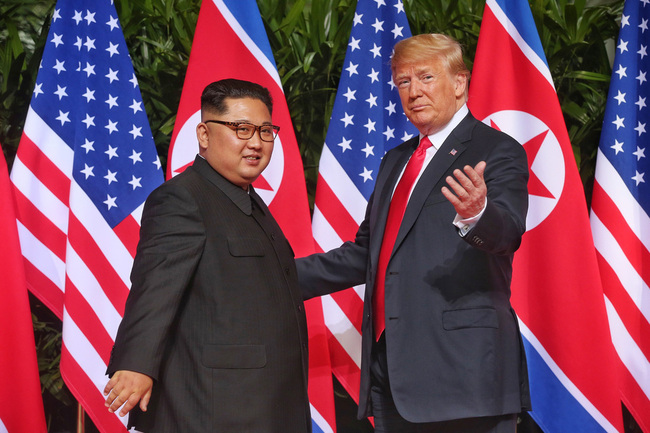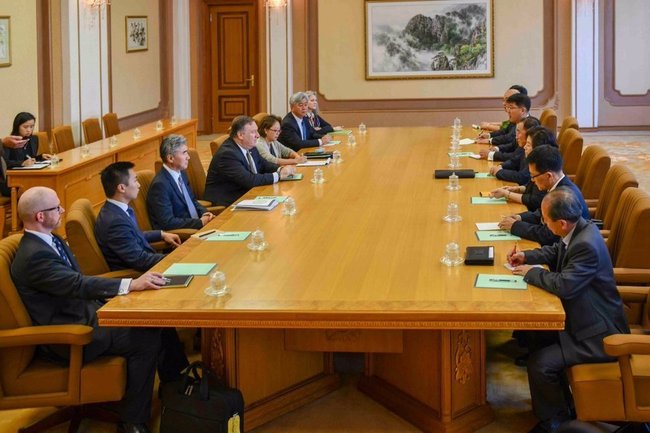 |
|
North Korean leader Kim Jong-un and US President Donald Trump pose for a photograph at the Capella hotel in Singapore before their historic June 12 summit. (Kevin Lim, provided by The Straits Times)
|
North Korea insists on “future” nuclear weapons while US focuses on complete shutdown
As of July 12, one month has passed since US President Donald Trump and North Korean leader Kim Jong-un held their historic meeting in Singapore, the first ever summit between the two countries. Following US Secretary of State Mike Pompeo’s third visit to North Korea on July 6 and 7, the “battle of nerves” between the two sides – a phenomenon often seen at the beginning of negotiations -- has intensified as they began to haggle over what they’re willing to trade. One month after the summit, progress toward the four points to which North Korea and the US agreed in their joint statement – namely, establishing new relations, building a peace regime on the Korean Peninsula, achieving complete denuclearization of the peninsula, and repatriating the remains of US soldiers – has been slower than the initial excitement would have suggested. First, in regard to the first point about the complete denuclearization of the Korean Peninsula, which was a key part of the agreement, North Korea looks as if it only wants to include its “future nukes” on the agenda. The North’s promise to shut down an ICBM engine testing site, along with its demolition of the nuclear test site at Punggye Village shortly before the summit, represents its future nuclear capability. The compromise reached on the engine testing site shutdown during Pompeo’s third trip to the North had to do with holding working-level talks. During Pompeo’s third trip, he appears to have focused on the issue of North Korea’s disclosure and verification of the nuclear weapons it currently possesses (its “past nukes”) and all of its nuclear and missile facilities (its “current nukes”). The North countered by characterizing this as a “one-sided and gangster-like” demand (in a July 7 statement by the spokesperson of the Foreign Ministry). Nor was the US able to produce a general timetable for denuclearization, which had been its original goal. The fierce tug-of-war over the agenda between North Korea, which is focusing on “future nukes,” and the US, which wants to put all nuclear weapons – past, present and future – on the table, is unlikely to end without a sweeping bargain that can break the deadlock. The problem is that the North is reluctant to throw away its “lifeline” as long as it is uncertain what reward it will receive from the US. Reversibility of military exercise suspensions, irreversibility of complete nuclear shutdown Second, the agreement to build a lasting peace regime on the Korean Peninsula depends on US compensation for North Korea’s resolution to denuclearize. Shortly after the summit, the US preemptively announced that it was halting joint military exercises with South Korea in the interest of building trust. North Korea regards this message as reversible and said it is not worth as much as its “irreversible” destruction of the nuclear test site at Punggye Village. The North argues that the US needs to sweeten the pot to make the deal fair. But the US counters by insisting that it took a major step that could weaken the foundation of its alliance with the South and that the North ought to therefore take further measures toward denuclearization. The two sides also have conflicting opinions about declaring the end of the Korean War, which would be an initial and symbolic step down the path of building a peace regime. North Korea argues that the US is dragging its feet on something it has already agreed to do. The US seems to regard the declaration as premature because it could provoke calls for the dissolution of the UN Command and the removal of US troops from the Korean Peninsula. The US is also reluctant to make the declaration without additional concessions from the North. Third, the US and North Korea had agreed to hold working-level talks about repatriating the remains of US service members at Panmunjeom on July 12, but the North Korean contingent never appeared. Though Trump has said that the remains would be repatriated soon, things do not seem to be going smoothly. Since this is of considerable interest to Trump and a sensitive issue for the American public, there could be trouble if this falls through. Finally, the two sides have been unable to embark on resetting their relations. There has been no mention of setting up a liaison office, nor have they apparently managed to reach an agreement on rudimentary events for cultural exchange, such as a Taekwondo demonstration.
 |
|
High-level talks between North Korea and the US on July 7. Representing the US were Secretary of State Mike Pompeo; US Ambassador to the Philippines Sung Kim; Alex Wong, Deputy Assistant Secretary of the Bureau of East Asia and Pacific Affairs in the State Department; Andrew Kim, head of the CIA’s Korea Mission Center; and Allison Hooker, Korea specialist on the White House National Security Council. Representing North Korea were Kim Yong-chol; Vice Foreign Minister Choe Son-hui; Choe Kang-il, the Foreign Ministry’s deputy director general for North American affairs; and Kim Song-hye, head of the unification strategy office at the WPK’s United Front Department. (from Pompeo’s Twitter account)
|







